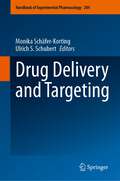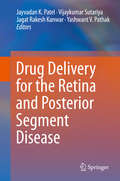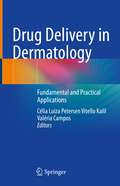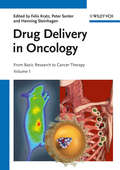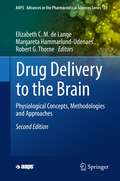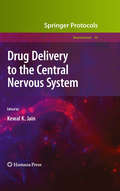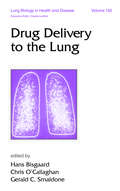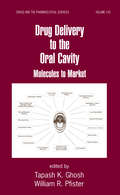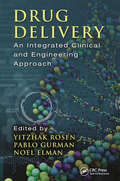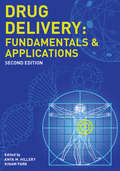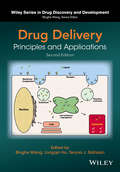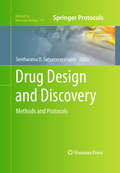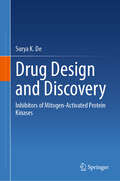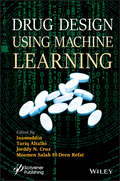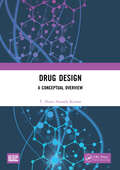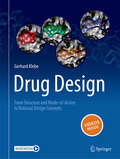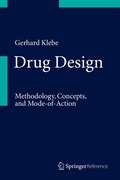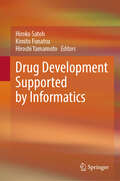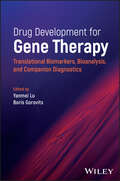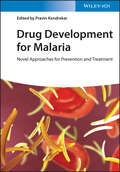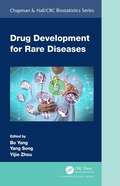- Table View
- List View
Drug Delivery and Targeting (Handbook of Experimental Pharmacology #284)
by Monika Schäfer-Korting Ulrich S. SchubertSince the publication of the Handbook of Experimental Pharmacology Vol. 197 in 2010 there have been important advances in drug development, drug delivery and – more recently – drug targeting. This is in particular relevant with the new generation of drugs acting on the immune system and tumors. These are quite often accompanied by major adverse reactions. Safe therapy is, therefore, an important area of research, in particular in chronic diseases and in persons of old age. In addition, the Covid-19 pandemic has brought renewed attention to vaccinations against viral infections, and mRNA vaccines have been tested for vaccination in tumor therapy, too. Vaccine delivery has stimulated important research on carriers which may pave the way for other applications and enhance a path to e.g. CRISPR-cas therapy.
Drug Delivery for the Retina and Posterior Segment Disease
by Vijaykumar Sutariya Jayvadan K. Patel Jagat Rakesh Kanwar Yashwant V. PathakThis book addresses the issues relating to a wide variety of ocular diseases from which millions of people suffer. Long-term challenges include visual impairment and ocular blindness. Certain ocular diseases are quite rare, whereas others, such as cataracts, age-related macular degeneration (AMD), and glaucoma, are very common, especially in the aging population. A rapid expansion of new technologies in ocular drug delivery and new drug candidates, including biologics, to treat these challenging diseases in the retina and posterior segments of the eye have recently emerged. These approaches are necessary because the eye has many unique barriers to drug delivery. Thus, this timely reference Drug Delivery for the Retina and Posterior Segment Disease compiles and analyzes recent advances in the research and development of drug delivery systems for retina and posterior segment diseases of the eye, with an emphasis on the use of implantable devices, iontophoresis as well as micro- and nanoparticles.
Drug Delivery in Dermatology: Fundamental and Practical Applications
by Célia Luiza Petersen Vitello Kalil Valéria CamposSkin accounts for approximately 15% of an adult’s total body weight, with a surface of about 2m². It provides an entry and exit barrier to various substances, offers effective protection against harmful substances, microorganisms and ultraviolet radiation, and is also paramount in immunology and body homeostasis, preventing dehydration and loss of essential minerals.The topical route has a number of advantages over oral and parenteral routes: no first-pass metabolism, greater convenience resulting in better treatment compliance, lower side-effect frequency, and prompt dosing cessation if required. However, the stratum corneum allows penetration of only 1 to 5% of substances applied topically, making this application route much less efficient. Lipophilic and small molecules (up to 500 Da) can cross the stratum corneum, since keratinocytes are covered by a lipid matrix, while it is virtually impossible for hydrophilic and large drugs to cross intact, normal skin, which means that passive topical delivery is restricted. To address this, techniques have been developed aimed at optimizing drug skin penetration by means of chemical, mechanical and physical methods, such as adding permeating active agents and using occlusion, iontophoresis, microneedling, lasers and intense pulsed light, and it is now possible to deliver medication to different skin layers or transdermally to the systemic circulation. Drug delivery is a hot topic in dermatology, with a Pubmed search generating 203431 articles. Offering a detailed review of this emerging therapeutic option, including the various methods available, this unique book guides physicians and doctors in selecting the correct technologies, technique and products for each patient.
Drug Delivery in Oncology: From Basic Research to Cancer Therapy
by Henning Steinhagen Peter Senter Felix KratzIn this first authoritative overview on modern cancer chemotherapy 121 international specialists have contributed their experience and recent data for what is likely to become the gold standard in the field. The authors summarize knowledge gained over the past decade, from basic concepts to successful applications in the clinic, covering active and passive targeting strategies as well as tissue-specific approaches. All current and future targeted delivery systems are discussed, from ligand-based to antibody-based polymer-based systems, right up to micro- and nanoparticulate systems. A special section covers the delivery of nucleic acid therapeutics, such as siRNA, miRNA and antisense nucleotides. In each case, a description of the basic technique is followed by a discussion of the latest preclinical and clinical developments in the field. By virtue of its clear and didactic structure, rich illustrative material and summary chapters, this handbook and ready reference enables the efficient transfer of knowledge between different disciplines, from basic research to the clinician and vice versa. It is equally well suited for professionals, researchers and students in medical oncology and cancer biology, and is also excellent for teaching medical students the foundations of 21st century cancer chemotherapy.
Drug Delivery to Tumors: Recent Strategies and Techniques
by Chong Li Lesheng Teng Zhaogang YangThis book aims to present the latest research on drug delivery systems. It summarizes emerging drug delivery strategies and new technologies for cancer treatment, viewed through the lens of cancer pathology. Topics include immunotherapy strategies, biomimetic drug delivery strategies, live cell drug delivery strategies, nanocrystal technology, and 3D printing technology. The book is intended for researchers, R&D engineers, and graduate students in the pharmaceutical field. Additionally, it is expected to inspire collaboration among experts from different disciplines to advance the development of drug delivery systems.
Drug Delivery to the Brain
by Margareta Hammarlund-Udenaes Elizabeth C.M. de Lange Robert G. ThorneThe development of new CNS drugs is notoriously difficult. Drugs must reach CNS target sites for action and these sites are protected by a number of barriers, the most important being the blood -brain barrier (BBB). Many factors are therefore critical to consider for CNS drug delivery, e. g. active/passive transport across the BBB, intra-brain distribution, and central/systemic pharmacokinetics, to name a few. Neurological disease and trauma conditions add further complexity because CNS barriers, drug distribution and pharmacokinetics are dynamic and often changed by disease/trauma. Knowledge of all these factors and their interplay in different conditions is of utmost importance for proper CNS drug development and disease treatment. In recent years much information has become available for a better understanding of the many factors important for CNS drug delivery and how they interact to affect drug action. This book describes small and large drug delivery to the brain with an emphasis on the physiology of the BBB and the principles and concepts for drug delivery across the BBB and distribution within the brain. It contains methods descriptions for studying drug delivery, routes and approaches of administering drugs into the brain, the influence of disease, and drug industry perspectives. Therewith, it contributes to an in-depth understanding of the interplay between brain (patho)-physiology and drug characteristics. Furthermore, the content is designed to be both cutting-edge and educational, so that the book can be used in high-level training of academic and industry scientists with full references to original publications.
Drug Delivery to the Brain: Physiological Concepts, Methodologies and Approaches (AAPS Advances in the Pharmaceutical Sciences Series #33)
by Margareta Hammarlund-Udenaes Robert G. Thorne Elizabeth C. M. de LangeThe development of new CNS drugs is notoriously difficult. Drugs must reach CNS target sites for action and these sites are protected by a number of barriers, the most important being the blood–brain barrier (BBB). Many factors are therefore critical to consider for CNS drug delivery, e.g. active/passive transport across the BBB, intra-brain distribution, and central/systemic pharmacokinetics, to name a few. Neurological disease and trauma conditions add further complexity because CNS barriers, drug distribution and pharmacokinetics are dynamic and often changed by disease/trauma. Knowledge of all these factors and their interplay in different conditions is of utmost importance for proper CNS drug development and disease treatment. In recent years much information has become available for a better understanding of the many factors important for CNS drug delivery and how they interact to affect drug action. This book describes small and large drug delivery to the brain with an emphasis on the physiology of the BBB and the principles and concepts for drug delivery across the BBB and distribution within the brain. It contains methods descriptions for studying drug delivery, routes and approaches of administering drugs into the brain, the influence of disease, drug industry perspectives, and a primer on neuroanatomy and physiological considerations written specifically for drug delivery scientists. Therewith, it contributes to an in-depth understanding of the interplay between brain (patho)-physiology and drug characteristics. Furthermore, the content is designed to be both cutting-edge and educational, so that the book can be used in high-level training of academic and industry scientists with full references to original publications.
Drug Delivery to the Central Nervous System
by Kewal K. JainPlaying an important role in the treatment of neurological disorders, the delivery of drugs to central nervous system (CNS), both administered directly and administered systematically for targeted action, encounters a major challenge in the form of the blood-brain barrier (BBB), which limits the access of drugs to the brain substance. In Drug Delivery to the Central Nervous System, experts in the field present essential methods used to deliver therapeutics across the BBB, both in experimental animals and in humans. In addition to those methods, several overviews of innovative methods and their applications are presented in order to give a glimpse of the future of this research. As a volume in the successful Neuromethods series, this book presents its protocols with the kind of detailed description and implementation advice that is crucial for getting optimal results. Authoritative and cutting-edge, Drug Delivery to the Central Nervous System serves as an ideal guide to scientists continuing to pursue knowledge of the delicate interactions between pharmaceuticals and the brain.
Drug Delivery to the Lung
by Hans Bisgaard Gerald C. Smaldone Chris O’CallaghanThis book focuses on the aerosol treatment of lung diseases, recent improvements in the understanding of proper dosage, and major innovations in device technology applied to clinical practice. Examines the behavior of inspired spherical particles in the respiratory tract!Featuring over 1300 references, drawings, tables, and photographs.
Drug Delivery to the Oral Cavity: Molecules to Market (Drugs and the Pharmaceutical Sciences)
by Tapash K. Ghosh William R. PfisterWith contributions from recognized authorities in industry, academia, and government, this reference presents the state-of-the-art in the testing, formulation, and clinical evaluation of intraoral drug delivery products-summarizing intraoral dosage forms in various stages of research, as well as products currently on the market.
Drug Delivery: An Integrated Clinical and Engineering Approach
by Yitzhak Rosen Pablo Gurman Noel ElmanIntegrating the clinical and engineering aspects of drug delivery, this book offers a much needed comprehensive overview and patient-oriented approach for enhanced drug delivery optimization and advancement. Starting with an introduction to the subject and pharmacokinetics, it explores advances for such topics as oral, gastroretentive, intravitreal, and intrathecal drug delivery, as well as insulin delivery, gene delivery, and biomaterials-based delivery systems. It also describes drug delivery in cancer, cardiac, infectious diseases, airway diseases, and obstetrics and gynecology applications. Examining special clinical states requiring innovative drug delivery modifications, such as hypercoagulability often seen in pregnancy, cancer, and autoimmune diseases, the book also discusses methods for improved drug delivery in clinical settings using clinical end points, clinical trials, simulations, and other venues. It also describes the latest drug delivery advances involving nanomaterials, NEMS and MEMS devices, hydrogels, microencapsulation, lipids, stem cells, patches, and ultrasound. The book is rounded out by a chapter on the FDA regulatory and bioethical challenges involved in advancing drug delivery.
Drug Delivery: Fundamentals and Applications, Second Edition
by Kinam Park Anya M HilleryThis book provides a comprehensive introduction to advanced drug delivery and targeting, covering their principles, current applications, and potential future developments. This edition has been updated to reflect significant trends and cutting-edge advances that have occurred since the first edition was published. All the original chapters have been retained, but the material therein has been updated. Eight new chapters have been added that deal with entirely new technologies and approaches.
Drug Delivery: Principles And Applications
by Binghe Wang Longqin Hu Teruna J. SiahaanFollowing its successful predecessor, this book covers the fundamentals, delivery routes and vehicles, and practical applications of drug delivery. In the 2nd edition, almost all chapters from the previous are retained and updated and several new chapters added to make a more complete resource and reference. * Helps readers understand progress in drug delivery research and applications * Updates and expands coverage to reflect advances in materials for delivery vehicles, drug delivery approaches, and therapeutics * Covers recent developments including transdermal and mucosal delivery, lymphatic system delivery, theranostics * Adds new chapters on nanoparticles, controlled drug release systems, theranostics, protein and peptide drugs, and biologics delivery
Drug Design
by Kenneth M. Merz Charles H. Reynolds Dagmar RingeStructure-based (SBDD) and ligand-based (LBDD) drug design are extremely important and active areas of research in both the academic and commercial realms. This book provides a complete snapshot of the field of computer-aided drug design and associated experimental approaches. Topics covered include X-ray crystallography, NMR, fragment-based drug design, free energy methods, docking and scoring, linear-scaling quantum calculations, QSAR, pharmacophore methods, computational ADME-Tox, and drug discovery case studies. A variety of authors from academic and commercial institutions all over the world have contributed to this book, which is illustrated with more than 200 images. This is the only book to cover the subject of structure and ligand-based drug design, and it provides the most up-to-date information on a wide range of topics for the practising computational chemist, medicinal chemist, or structural biologist. Professor Kenneth Merz has been selected as the recipient of the 2010 ACS Award for Computers in Chemical & Pharmaceutical Research that recognizes the advances he has made in the use of quantum mechanics to solve biological and drug discovery problems.
Drug Design and Discovery
by Seetharama D. SatyanarayanajoisResearch in the pharmaceutical sciences and medicinal chemistry has taken an important new direction in the past two decades with a focus on large molecules, especially peptides and proteins, as well as DNA therapeutics. In Drug Design and Discovery: Methods and Protocols, leading experts provide an in-depth view of key protocols that are commonly used in drug discovery laboratories. Covering both classic and cutting-edge techniques, this volume explores computational docking, quantitative structure-activity relationship (QSAR), peptide synthesis, labeling of peptides and proteins with fluorescent labels, DNA-microarray, zebrafish model for drug screening, and other analytical screening and biological assays that are routinely used during the drug discovery process. Written in the highly successful Methods in Molecular BiologyTM series format, chapters include introductions to their respective topics, lists of the necessary materials, step-by-step, readily reproducible laboratory protocols, and tips on troubleshooting and avoiding known pitfalls. Thorough and accessible, Drug Design and Discovery: Methods and Protocols serve as a vital laboratory reference for pharmaceutical chemists, medicinal chemists, and pharmacologists as well as for molecular biologists.
Drug Design and Discovery: Inhibitors of Mitogen-Activated Protein Kinases
by Surya K. DeThis book covers the important role small molecules can play in the modulation of stress-activated protein kinase (SAPK), also called the mitogen-activated protein kinase (MAPK) pathway, and the potential this may offer in enabling the development of future medicine therapies. It is clear that MAP kinase pathway therapies could continue to drive increasing interest in the field, both within academic laboratories and also in the biotechnology and pharmaceutical sectors. This book provides an overview of protein kinase inhibitors, the biological roles of MAP kinases, ATP-competitive and non-competitive inhibitors, covalent inhibitors, and more. This book is intended for professors in academia, researchers in pharmaceutical and biotechnology sectors working on protein kinases, and graduate students in pharmacy/chemistry.
Drug Design using Machine Learning
by Inamuddin Tariq Altalhi Jorddy N. Cruz Moamen Salah El-Deen RefatDRUG DESIGN USING MACHINE LEARNING The use of machine learning algorithms in drug discovery has accelerated in recent years and this book provides an in-depth overview of the still-evolving field. The objective of this book is to bring together several chapters that function as an overview of the use of machine learning and artificial intelligence applied to drug development. The initial chapters discuss drug-target interactions through machine learning for improving drug delivery, healthcare, and medical systems. Further chapters also provide topics on drug repurposing through machine learning, drug designing, and ultimately discuss drug combinations prescribed for patients with multiple or complex ailments. This excellent overview Provides a broad synopsis of machine learning and artificial intelligence applications to the advancement of drugs; Details the use of molecular recognition for drug development through various mathematical models; Highlights classical as well as machine learning-based approaches to study target-drug interactions in the field of drug discovery; Explores computer-aided technics for prediction of drug effectiveness and toxicity. Audience The book will be useful for information technology professionals, pharmaceutical industry workers, engineers, university researchers, medical practitioners, and laboratory workers who have a keen interest in the area of machine learning and artificial intelligence approaches applied to drug advancements.
Drug Design: A Conceptual Overview
by T. Durai KumarThe newer research areas in pharmaceutical sciences, particularly molecular modeling and simulations, prompted a more efficient drug discovery process. Informatics integrated with pharmaceutical sciences (cheminformatics and bioinformatics) became an essential component of drug research. Drug informatics such as genomics and proteomics assists in the Rational Drug Design (RDD). This emerging discipline is known as “Computer-Aided Drug Design" (CADD), which has profound application in RDD. The advanced and adequate practice in drug design informatics is essential for pharmacy graduates. Hence, a companion for acquiring knowledge on these concepts is vital. The students of B. Pharmacy, M. Pharmacy (Pharmaceutical Chemistry, Pharmacology, and Pharmaceutics), biotechnology, biomedical engineering and other interdisciplinary fields may find this book as a reference guide. The salient features of this book are: • Systematic and simple approach • Emphasis on traditional and modern drug design strategies • Comprehensive coverage for the current advances in the drug design • Experimental section to ensure hands-on-experience Note: T& F does not sell or distribute the Hardback in India, Pakistan, Nepal, Bhutan, Bangladesh and Sri Lanka.
Drug Design: From Structure and Mode-of-Action to Rational Design Concepts
by Gerhard KlebeThis English-language textbook, based on the successful German edition 'Wirkstoffdesign', brings the subject of drug design back to the cutting edge of research. The reader learns about new methods in genetic engineering and the expanded range of structural biological methods. Especially in the last 10 years, many complex target structures such as G-protein coupled receptors or ion channels have been elucidated by using these methods. The reader learns how these long-sought complex structures with classical drugs look like and how the therapeutic effect is achieved.This textbook is aimed at students of pharmacy, chemistry and the life sciences, but also at career changers and medicinal chemists in research and development departments of the pharmaceutical industry. Conceptually, it is very different from classical textbooks on pharmaceutical chemistry. It focuses on the path to a new drug substance. The selection of case studies is based on didactic aspects and attempts to give a broad overview of methods and strategies without forgetting to look back at the beginnings of this field of work. Thus, the arc spans from the history of drug research, the mechanisms of action of drugs and the methods for lead structure search and optimisation to structure determination methods, modelling, molecular dynamics and QSAR methods to structure- and computer-aided design.This textbook also discusses new methods and concepts such as epigenetics, the PROTAC approach, CRISPR-Cas9 gene scissors, structural predictions from sequence, the use of artificial intelligence and new screening technologies from biophysics. It presents successes in disrupting or enhancing protein-protein interactions as a concept for drug therapy and discusses optimising drugs considering their thermodynamic as well as kinetic binding profiles .Videos via app: simply download the SN More Media app free of charge, scan a link with the play button and immediately play the video on your smartphone or tablet.
Drug Design: Methodology, Concepts, and Mode-of-Action
by Gerhard KlebeUnique work on structure-based drug design, covering multiple aspects of drug discovery and development. Fully colored, many images, computer animations of 3D structures (these only in electronic form). Makes the spatial aspects of interacting molecules clear to the reader, covers multiple applications and methods in drug design. Structures by mode of action, no therapeutic areas. Of high relevance for academia and industrial research. Focus on gene technology in drug design, omics-technologies computational methods experimental techniques of structure determination multiple examples on mode of action of current drugs, ADME-tox properties in drug development, QSAR methods, combinatorial chemistry, biologicals, ribosome, targeting protein-protein interfaces.
Drug Development (Routledge Revivals)
by Charles E. HamnerPublished in 1990: Overall the volume stands as a relatively comprehensive but not exhaustive summation of the complex process of drug development.
Drug Development Supported by Informatics
by Hiroko SatohThis book describes the state-of-the-art of chemoinformatics, bioinformatics, materials informatics and measurement/metrology informatics to develop drugs with desired activity or physicochemical properties and to optimize the functionality, efficacy, safety and quality of the compounds for drugs. Recently, "AI drug discovery", drug discovery research utilizing artificial intelligence technology such as machine learning, has attracted much attention. This book provides an overview of the four applied informatics fields and their applications in drug development for a wide spectrum of readers from learners to professional scientists in academia and industry. It focuses on the basic research stage of drug development with contributions from experts at the forefront of these fields. The authors hope that this book will be of assistance to explore new opportunities for collaboration between pharmaceutical science and informatics.
Drug Development for Gene Therapy: Translational Biomarkers, Bioanalysis, and Companion Diagnostics
by Yanmei Lu Boris GorovitsDrug Development for Gene Therapy Industry-centric perspective on translational and bioanalytical challenges and best practices for gene therapies Drug Development for Gene Therapy focuses on the translational and bioanalytical challenges and best practices for gene therapy modalities, presenting a significant body of data, including information related to safety and efficacy, necessary to advance through the development pipeline into clinical use. The text covers bioanalytical methods and platforms including patient screening assays, different PCR tests, enzyme activity assays, ELISpot, NGS, LC/MS, and immunoassays, with FDA and EMA guidelines on gene therapy safety and efficacy, along with companion diagnostics regulations from US and EU perspectives. The chapters offer an in-depth discussion of the basics and best practices for translational biomarkers, bioanalysis, and developing companion diagnostics / lab tests for gene therapies in the pharma and biopharma industries. To aid in reader comprehension, the text includes clinical examples of relevant therapies in related chapters. Some of the core topics covered include study design, immunogenicity, various bioanalytical methods and their applications, and global regulatory issues. Written by two highly qualified authors with significant experience in the field, Drug Development for Gene Therapy includes information on: Bioanalytical methods to detect pre-existing antibodies against adeno-associated viruses (AAV) capsids Detection of cellular immunity and humoral response to viral capsids and transgene proteins, and immunogenicity of gene therapy products Nonclinical and clinical study considerations and methods for biodistribution and shedding Quantification of transgene protein expression and biochemical function, and substrate and distal pharmacodynamic biomarker measurements for gene therapy Detection and quantification of rAAV integration and off-target editing Current regulatory landscape for gene therapy product development and the role of biomarkers and general regulatory considerations for gene therapy companion diagnostics With comprehensive coverage of the subject, Drug Development for Gene Therapy is a must-have resource for researchers and developers in the areas of pharmaceuticals, biopharmaceuticals, and contract research organizations (CROs), along with professors, researchers, and advanced students in chemistry, biological, biomedical engineering, pharmaceuticals, and medical sciences.
Drug Development for Malaria: Novel Approaches for Prevention and Treatment
by Pravin KendrekarDrug Development for Malaria Provides readers with first-hand advice for the development of novel antimalarial drugs This book provides a systematic overview of antimalarial drug development and presents a wealth of data and insight from drug developers across three continents, including many from countries where the disease is endemic. Throughout, the contributions have been written with the drug developer in mind, highlighting challenges but also opportunities for the successful development of effective antimalarial drugs. Case studies and method-oriented chapters provide an abundance of practical first-hand advice on how to successfully develop an antimalarial drug. Key topics covered in the book include: The performance of current drugs and therapies, the influence of formulation and targeted delivery, and strategies to overcome drug resistance. Technologies and approaches for development of novel drugs, such as assays, computer-aided drug design, known and potential drug targets, and natural sources for novel antimalarial compounds Vaccination as an alternative to drug therapy For chemists and other professionals working in industries related to medicine and pharmaceuticals, this book provides a completely comprehensive overview of the current state of novel antimalarial drugs and how they can be developed in an efficient and cost-effective manner.
Drug Development for Rare Diseases (Chapman & Hall/CRC Biostatistics Series)
by Yang BoA disease is defined as rare if the prevalence is fewer than 200,000 in the United States. It is estimated that there are more than 7,000 rare diseases, which collectively affect 30 million Americans or 10% of the US population. This diverse and complex disease area poses challenges for patients, caregivers, regulators, drug developers, and other stakeholders. This book is proposed to give an overview of the common issues facing rare disease drug developers, summarize challenges specific to clinical development in small populations, discuss drug development strategies in the evolving regulatory environment, explain generation and utilization of different data and evidence inside and beyond clinical trials, and use recent examples to demonstrate these challenges and the development strategies that respond to the challenges. Key Features: • Rare disease. • Drug development. • Innovative clinical trial design. • Regulatory approval. • Real-world evidence.
